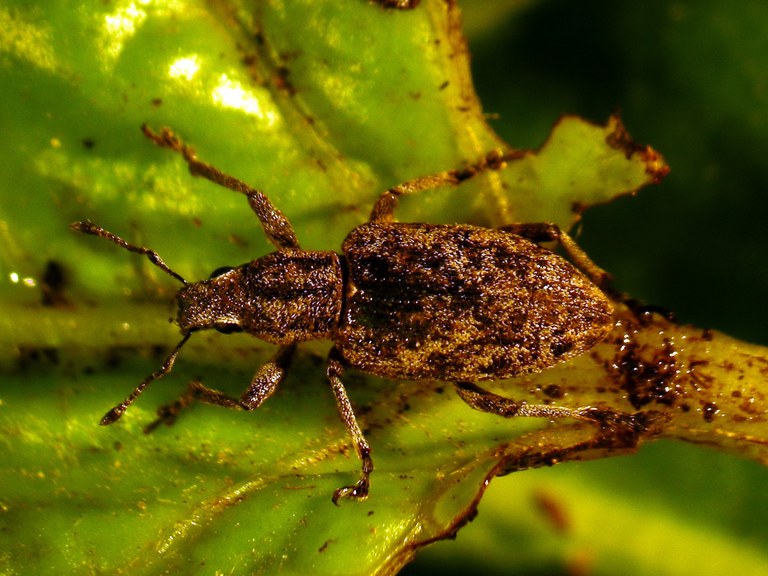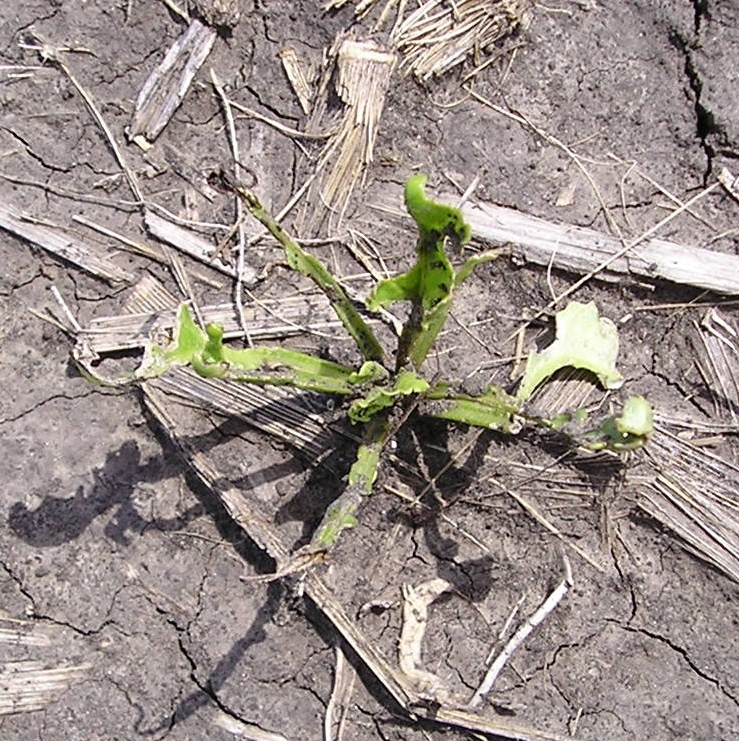Leaf-feeding Weevil in Sugar Beets (E1273, Revised Sept. 2016)
Availability: Web only
Description and Biology
Leaf-feeding weevils are mottled brown to brownish gray (Figure 1), and their bodies are covered with minute, gray, hairlike structures. Because this weevil is a rare sugar beet pest and it has not been reported on other crops grown in the area, little is known about its biology or its control.

Figure 1. Adult leaf-feeding weevil on damaged sugar beet leaf. (NDSU photo)
Researchers believe the insect overwinters as an adult in the soil or in plant residues. Adult weevils emerge in the spring and mate, and females then deposit eggs in host plant tissues. Known host plants include pigweed, cocklebur, wild sunflower and ragweed species.
Larvae (immature weevils) are believed to feed on these plants until they develop into adults. The adults then re-infest these hosts or, on occasion, infest neighboring sugar beet plants. No larvae have been observed feeding on sugar beets.
Damage
Damaging infestations of leaf-feeding weevils in sugar beet fields usually have occurred during the first three weeks in May, although weevils also have been observed feeding on sugar beets as late as June.
Adult weevils use chewing mouthparts to feed on cotyledons and leaves of young sugar beet plants (Figure 2). Field damage usually appears as circular or oval-shaped patches in affected areas (Figure 3). The weevils generally feed on leaf edges and interveinal areas but usually leave the midrib intact.

Figure 2. Leaf-feeding weevil damage on young sugar beet plant. (NDSU photo)

Figure 3. Bare patch in sugar beet field caused by leaf-feeding weevils. (Photo courtesy of Lonnie Buss, retired Southern Minnesota Beet Sugar Cooperative agriculturist)
Significant feeding damage can result in seedling death. Younger plants are especially vulnerable to attack. Weevils are difficult to find on or near damaged plants because they fall to the ground and “play dead” by remaining motionless after being disturbed. Also, their dark mottled coloring makes them difficult to detect on the ground. Careful inspection will reveal the insects in plant debris or in the soil immediately surrounding damaged plants.
Management
Control of early season broadleaf weeds should be an effective cultural strategy for minimizing the risk of weevil feeding injury to sugar beets. Field scouting for adult weevils and timely application of insecticides will be necessary to control damaging populations. Insecticides labeled for use on sugar beets that have activity as stomach poisons in other beetles, especially weevils, should control the leaf-feeding weevil.
Acknowledgements
Partial printing costs of this publication were provided by the Sugarbeet Research and Education Board of Minnesota and North Dakota, which had no editorial input into the content.
Selected References
Armstrong, J.S., A. Cattanach and L. Buss. 1998. Defoliating weevil identified and damage described from the southern Minnesota Beet Sugar Coop area. In: 1997 Sugarbeet Res. Ext. Rep. 28: 256-257.
This publication was authored by Mohamed Khan, NDSU Extension/University of Minnesota sugar beet specialist; Mark Boetel, NDSU research and Extension entomologist; and Lonny Buss, Southern Minnesota Beet Sugar Cooperative agriculturist, 2004.
Revised September 2016


